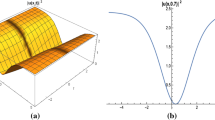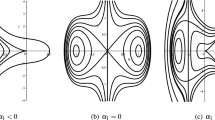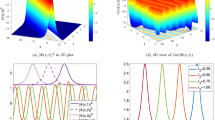Abstract
This study reveals the dark, bright, combined dark–bright, singular, combined singular optical solitons and singular periodic solutions to the conformable space–time fractional complex Ginzburg–Landau equation. We reach such solutions via the powerful extended sinh-Gordon equation expansion method (ShGEEM). Constraint conditions that guarantee the existence of valid solitary wave solutions are given. Under suitable choice of the parameter values, interesting three-dimensional graphs of some of the obtained solutions are plotted.
Similar content being viewed by others
Avoid common mistakes on your manuscript.
1 Introduction
The investigation of soliton propagation through nonlinear optical fibres as a theory of optical solitons has become one of the interesting research areas [1, 2]. It is well known that optical solitons represent a treasure trove of research in the field of nonlinear optics. Optical solitons play vital roles in the field of fibre optics, photonics, quantum electronics, optoelectronics and so on [3]. Various integral schemes have been used to investigate different kinds of nonlinear Schrödinger equations (NLSE) [4,5,6,7,8,9,10,11,12,13,14,15,16,17,18,19,20,21,22,23,24,25,26,27,28,29,30,31,32].
For the past two decades, the study of fractional differential equations has attracted the attention of many scientists [33, 34]. Several definitions of fractional differential equations have been submitted to the literature, such as Riemann–Liouville, Grunwald–Letnikov, the Caputo, Atangana–Baleanu derivative in Caputo sense, Atangana–Baleanu fractional derivative in Riemann–Liouville sense and modified Riemann–Liouville [35,36,37,38]. Recently, Khalil et al [39] developed the conformable fractional derivative, which can simply be used to transform fractional nonlinear partial differential equations to nonlinear ordinary equations.
This paper is devoted for obtaining optical solitons and singular periodic wave solutions to the conformable space–time fractional complex Ginzburg–Landau (GL) equation [2, 3] by utilising the powerful extended sinh-Gordon equation expansion method (ShGEEM) [40,41,42,43,44]:
where x and t are the non-dimensional distance along the fibre and time in dimensionless form, respectively. The unknown function \(\Psi \) is the complex-valued function of x and t, the symbol \(*\) stands for the complex conjugate of the unknown function \(\Psi \), a and b are the coefficients of the group velocity dispersion and nonlinearity, respectively. The real-valued constants \(\nu ,\;\varrho ,\;\gamma \) are coefficients from the perturbation effects [45, 46]. F is a real-valued algebraic function which must have the smoothness of the function \(F(|\Psi |^{2})\Psi {:}\mathbb {C}\rightarrow \mathbb {C}\). When the complex plane \(\mathbb {C}\) is considered as 2D linear space \(\mathbb {R}^{2}\), the function \(F(|\Psi |^{2})\Psi \) is k times continuously differentiable [47].
2 The conformable fractional derivative
In this section, basic definition, properties and theorem about conformable fractional derivative are discussed [39].
DEFINITION 1
Let \(g: (0,\infty )\rightarrow \mathbb {R}\), then the conformable fraction derivative of g of order \(\alpha \) is defined as
Here, some basic properties of the conformable fractional derivative [39] are presented:
-
1.
\(T_{\alpha }(bg+ch)=bT_{\alpha }(g)+cT_{\alpha }(h)\), \(b, c\in \mathbb {R}\).
-
2.
\(T_{\alpha }(t^{\lambda })=\lambda t^{\lambda -\alpha }\), \(\lambda \in \mathbb {R}\).
-
3.
\(T_{\alpha }(gh)=gT_{\alpha }(h)+hT_{\alpha }(g)\).
-
4.
\(T_{\alpha }(g/h)={((hT_{\alpha }(g)-gT_{\alpha }(h))}/{h^{2}})\).
-
5.
If g is differentiable, then \(T_{\alpha }(g)(t)=t^{1-\alpha }({{\mathrm {d}}g}/{{\mathrm {d}}t})\).
Theorem 1
Let \(g,h: (0,\infty )\rightarrow \mathbb {R}\) be differentiable and also \(\alpha \) differentiable functions. Then the following rule holds:
3 The extended ShGEEM
Consider the following space–time fractional sinh-Gordon equation [40]:
where \(\lambda \) is a non-zero constant.
Substituting the fractional travelling wave transformations
into eq. (5), we obtain the following nonlinear ordinary differential equation (NODE):
where \(\upsilon \) is the velocity of the travelling wave.
Integrating eq. (7) once, we obtain
where c is the constant of integration. Setting \(-({\lambda }/{\upsilon })=b\) and \({\psi }/{2}=\Theta \), eq. (8) becomes
For different values of parameters a and b, eq. (9) possesses the following sets of solutions:
Set I: When \(c=0\), \(b=1\), eq. (9) becomes
Simplifying eq. (10), the following solutions are secured:
and
where \(\mathrm {i}=\sqrt{-1}\).
Set II: When \(c=1\), \(b=1\), eq. (9) becomes
Simplifying eq. (13), the following solutions are obtained:
and
For a given nonlinear space–time fractional partial differential equation, say
the following steps are followed to secure various wave solutions to (16):
Step 1: We first transform eq. (16) into the following NODE by using eq. (6):
Step 2: We assume that eq. (17) has a new ansatz solution of the form
where \(\Theta \) is a function of \(\eta \) and it satisfies eq. (9), and \(A_{0},\;A_{k},\;B_{k}\) \((k=1,2,\ldots ,m)\) are constants to be determined later. To obtain the value of m, the homogeneous balance principle is used on the highest derivatives and highest power nonlinear term in eq. (17).
Step 3: We substitute eq. (28) and its derivatives with a fixed value of m along with eq. (10) or (13) into eq. (17) to obtain a polynomial equation in \(\Theta {'^s}\sinh ^{j}(\Theta )\cosh ^{k}(\Theta )\) \((s=0,1\; \text{ and }\;j,k=0,1,2,\ldots )\). We collect a set of overdetermined nonlinear algebraic equations in \(A_{0},\;A_{k},\;B_{k},\;\upsilon \) by summing the coefficients of \(\Theta {'^s}\sinh ^{j}(\Theta )\cosh ^{k}(\Theta )\) with the same power and setting each summation to zero.
Step 4: The obtained set of overdetermined nonlinear algebraic equations is then solved with the aid of symbolic software to determine the values of the parameters \(A_{0},A_{k},B_{k}\, {\mathrm {and}}\ \upsilon \).
Step 5: Using the results obtained in eqs (11), (12), (14) and (15), we have the wave solutions to the given nonlinear partial differential equation in the following forms:
and
4 Application
In this section, we obtain various solutions to the complex GL equation [3] by using the extended ShGEEM.
Consider the following complex fractional travelling wave transformation:
where \(\psi (\eta )\) stands for the pulse shape, \(\upsilon \) is the velocity of the soliton, \(\phi \) is the phase component, \(\vartheta \) is the soliton frequency, \(\omega \) is the soliton wave number and \(\Phi \) is the phase constant.
Substituting eq. (23) into eq. (1) yields the following NODE:
from the real part and the relation \(\upsilon =-2a\vartheta \) from the imaginary part.
Setting \(\nu =2\varrho \), eqs (1) and (24) become
and
respectively.
For the Kerr law nonlinearity, \(F(\psi )=\psi \) [3]. Therefore, eq. (26) becomes
The Kerr law nonlinearity arises from the fact that light wave in an optical fibre encounters nonlinear responses from the non-harmonic motion of electrons with an external electric field [2].
Balancing the terms \(\psi {''}\) and \(\psi ^{3}\) in eq. (27) yields \(m=1\).
With \(m=1\), eqs (28)–(32) take the following forms:
and
respectively (figure 1).
The 3D graphics of eq. (35) when (a) \(\alpha =\beta =0.7\) and (b) \(\alpha =\beta =0.6\).
Putting eq. (28) and its second derivative into eq. (27) give a polynomial in the power hyperbolic functions. We get a set of algebraic equations by equating each summation of the coefficients of the hyperbolic functions of the same power to zero. We solve the set of algebraic equations to get the values of the parameters involved. To explicitly secure the solutions of eq. (1), we insert the values of the parameters into each of eqs (29)–(32).
Set 1: When
eq. (1) possesses the following combined dark–bright and combined singular optical solitons:
and
The 3D graphics of eq. (43) when (a) \(\alpha =\beta =0.7\) and (b) \(\alpha =\beta =0.6\).
The 3D graphics of eq. (44) when (a) \(\alpha =\beta =0.7\) and (b) \(\alpha =\beta =0.6\).
respectively, where \(b(4\varrho -a)>0\) and \(a(a+2(\gamma -2\varrho +\omega ))<0\) for the existence of valid solitons (figure 2).
Set 2: When
eq. (1) possesses the following dark and singular optical solitons:
and
respectively, where \(b(4\varrho -a)>0\) and \(a(8\varrho -2a-\gamma -\omega )>0\) for the existence of valid solitons (figure 3).
Set 3: When
eq. (1) possesses the following bright and singular optical solitons:
and
respectively.
Valid solitons exist for both \(b(4\varrho -a)<0\) or \(b(4\varrho -a)>0\) and \(a(a-\gamma -4\varrho -\omega )>0\).
Set 4: When
eq. (1) possesses the following combined dark–bright and combined singular optical solitons:
and
respectively, where \(b(4\varrho -a)>0\) for valid solitons.
Set 5: When
eq. (1) possesses the following dark and singular optical solitons:
and
respectively, where \(b(4\varrho -a)>0\) for valid solitons.
Set 6: When
eq. (1) possesses the following bright and singular optical solitons:
and
respectively, where \(b(a-4\varrho )>0\) or \(b(a-4\varrho )<0\) for valid solitons.
Set 7: When
eq. (1) possesses the following dark and singular optical solitons:
and
respectively, where \(b(2+\vartheta ^{2})(\gamma +4\vartheta ^{2}\varrho +\omega )>0\) for valid solitons.
Set 8: When
eq. (1) possesses the following bright and singular optical solitons:
and
respectively, where \(b(\vartheta ^{2}-1)(\gamma +4\vartheta ^{2}\varrho +\omega )>0\) or \(b(\vartheta ^{2}-1)(\gamma +4\vartheta ^{2}\varrho +\omega )<0\) for valid solitons.
Set 9: When
eq. (1) possesses the following singular periodic solutions:
and
where \(b(4\varrho -a)>0\) or \(b(4\varrho -a)<0\) and \(a(a-2(\gamma +2\varrho +\omega ))>0\) for valid solitons.
Set 10: When
eq. (1) possesses the following singular periodic solutions:
and
where \(b(4\varrho -a)>0\) or \(b(4\varrho -a)<0\) for valid solitons.
5 Conclusions
This study used the powerful extended ShGEEM in constructing the dark, bright, combined dark–bright, singular, combined singular optical solitons and singular periodic wave solutions to the conformable space–time fractional complex GL equation. The constraint conditions for the existence of a valid soliton to each of the obtained solutions are stated. Under suitable choice of parameters, the 3D graphics of some of the obtained solutions are also plotted. The results reported may be useful in explaining the physical meaning of the studied equation in this paper and other complex nonlinear models arising in various fields of nonlinear science.
The computations in this paper provide a lot of encouragement to the future findings. It can be seen that the integral scheme used in this study is a powerful and efficient mathematical tool, which produces a family of solutions when applied to a complex nonlinear model. In our future research, we are going to consider investigating the conformable space–time fractional complex GL with a different type of nonlinearity. Its numerical solutions will also be computed.
References
M Mirzazadeh, M Eslami and Q Zhou, J. Nonlinear Opt. Phys. Mater. 24(2), 1550017 (2015)
A H Arnous, A R Seadawy, R T Alqahtani and A Biswas, Optik 144, 475 (2017)
M Mirzazadeh, M Ekici, A Sonmezoglu, M Eslami, Q Zhou, A H Kara, D Milovic, F B Majid, A Biswas and M Belić, Nonlinear Dyn. 85(3), 1979 (2016)
A Ali, A R Seadawy and D Lu, Optik 145, 79 (2017)
A M Wazwaz, Chaos Solitons Fractals 37, 1136 (2008)
H Bulut, T A Sulaiman and B Demirdag, Nonlinear Dyn. 91(3), 1985 (2018)
M Mirzazadeh, A H Arnous, M F Mahmood, E Zerrad and A Biswas, Nonlinear Dyn. 81(8), 277 (2015)
C Cattani, Int. J. Fluid Mech. Res. 30(5), 23 (2003)
H Triki and A M Wazwaz, J. Electromagn. Waves Appl. 30(6), 788 (2016)
T A Sulaiman, T Akturk, H Bulut and H M Baskonus, J. Electromagn. Waves Appl. 32(9), 1093 (2017)
H Bulut, T A Sulaiman and H M Baskonus, Superlatt. Microstruct. (2018), https://doi.org/10.1016/j.spmi.2017.12.009
S T R Rizvi, I Ali, K Ali and M Younis, Optik 127(13), 5328 (2016)
A Sardar, K Ali, S T R Rizvi, M Younis, Q Zhou, E Zerrad, A Biswas and A Bhrawy, J. Nanoelectron. Optoelectron. 11(3), 382 (2016)
H M Baskonus, T A Sulaiman, H Bulut and T Akturk, Superlatt. Microstruct. 115, 19 (2018)
M Eslami and A Neirameh, Opt. Quantum Electron. 50, 47 (2018)
M Arshad, A R Seadawy and D Lu, Eur. Phys. J. Plus 132, 371 (2017)
J Manafian and M F Aghdaei, Eur. Phys. J. Plus 131, 97 (2016)
M T Darvishi, S Ahmadian, S B Arbabi and M Najafi, Opt. Quantum Electron. 50, 32 (2018)
O Uruc and A Esen, Int. J. Mod. Phys. C 27(9), 1650103 (2016)
H Bulut, T A Sulaiman and H M Baskonus, Eur. Phys. J. Plus 132, 459 (2017)
A Esen and O Tasbozan, Ann. Math. Sil. 31, 83 (2017)
M Eslami, M Mirzazadeh and A Neirameh, Pramana – J. Phys. 84(1), 3 (2015)
M Matinfar, M Eslami and M Kordy, Pramana – J. Phys. 85(4), 583 (2015)
J Manafian and M Lakestani, Pramana – J. Phys. 85(1), 31 (2015)
A R Seadawy, Pramana – J. Phys. 89: 49 (2017)
K Roy, S K Ghosh and P Chatterjee, Pramana – J. Phys. 86(4), 873 (2016)
H Bulut, T A Sulaiman and H M Baskonus, Opt. Quantum Electron. 50(2), 87 (2018)
O A Ilhan, T A Sulaiman, H Bulut and H M Baskonus, Eur. Phys. J. Plus 133(1), 27 (2018)
E Bas and B Kilics, World Appl. Sci. J. 11(3), 256 (2010)
X J Yang, F Gao and H M Srivastava, Comput. Math. Appl. 73(2), 203 (2017)
X J Yang, D Baleanu and F Gao, Proc. Rom. Acad. Series A 18, 231 (2017)
R Yilmazer and E Bas, Int. J. Open Prob. Comput. Math. 5(2), 1 (2012)
R Yilmazer and O Ozturk, Abstr. Appl. Anal. 2013, 715258 (2013)
O Ozturk and R Yilmazer, Differ. Equ. Dyn. Syst. (2016), https://doi.org/10.1007/s12591-016-0308-8
E Barkai, R Metzler and J Klafter, Phys. Rev. E 61, 132 (2000)
M D Ortigueira, L Rodriguez-Germa and J J Trujillo, Commun. Nonlinear Sci. Numer. Simul. 16(11), 4174 (2011)
I Podlubny, Fractional differential equations (Academic Press, San Diego, 1999)
A Abdon and B Dumitru, Therm. Sci. 20(2), 763 (2016)
R Khalil, M Al Horani, A Yousef and M Sababheh, J. Comput. Appl. Math. 264, 65 (2014)
X Xian-Lin and T Jia-Shi, Commun. Theor. Phys. 50, 1047 (2008)
H Bulut, T A Sulaiman and H M Baskonus, Optik 163, 49 (2018)
H Bulut, T A Sulaiman and H M Baskonus, Optik 163, 1 (2018)
H M Baskonus, T A Sulaiman and H Bulut, Opt. Quantum Electron. 50, 165 (2018)
H M Baskonus, T A Sulaiman and H Bulut, Opt. Quantum Electron. 50, 15 (2018)
A Biswas, Prog. Electromagn. Res. 96, 1 (2009)
A Biswas and R T Alqahtani, Optik 147, 77 (2017)
M Mirzazadeh, M Ekici, A Sonmezoglu, M Eslami, Q Zhou, E Zerrad, A Biswas and M Belic, J. Comput. Theor. Nanosci. 13, 5361 (2016)
Author information
Authors and Affiliations
Corresponding author
Rights and permissions
About this article
Cite this article
Sulaiman, T.A., Baskonus, H.M. & Bulut, H. Optical solitons and other solutions to the conformable space–time fractional complex Ginzburg–Landau equation under Kerr law nonlinearity. Pramana - J Phys 91, 58 (2018). https://doi.org/10.1007/s12043-018-1635-9
Received:
Revised:
Accepted:
Published:
DOI: https://doi.org/10.1007/s12043-018-1635-9







